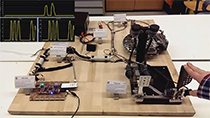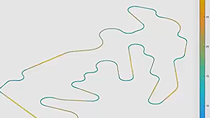Steady-State Lap Time Simulation
From the series: Student Teams Share Their Keys to Success
Paco Sevilla, Tufast Racing Team
Use lap time simulation to make better design decisions. Paco Sevilla, of TU Fast Formula Student team, and Christoph Hahn, of MathWorks, explain how lap time simulation can be used to compare vehicle concepts in the early design stage.
Reasons to use lap time simulation are varied. It allows performing parameter studies to evaluate racecar concepts and enables you to take advantage of the benefits of the aerodynamic package.
TUfast has integrated all algorithms into a clean and powerful app which allows the entire team to use the functionality. The basis for all calculations is the ggV-Diagram, often also denoted as the performance envelope. Paco explains the relation between maximum performance (velocity) and longitudinal and lateral acceleration (maximum forces that the tire-road interface can handle). Validation is crucial for TUfast as Paco illustrates. Before any decision is made based on the simulation tool, the team makes sure the vehicle model is representing the actual vehicle behavior with a maximum deviation of 5%.
A specialty at TUfast is their software tool without a driver model. The car is always evaluated at its limit using a steady-state approach. They divide the track into segments that are defined between corner apexes, where the corner radius is minimal, and pure lateral acceleration is assumed. Based on these segments, they integrate forward from e.g. apex 1 to 2 to determine maximum acceleration and from apex 2 to 1 they get the maximum possible deceleration by integrating backward. Intersecting both curves provides the point where the ideal driver would have to switch between acceleration and braking.
A good example to use simulation as a justification tool is also provided in the video. TUfast requires their aerodynamics team to evaluate aero efficiency, which is the ratio between down force and drag, for each concept they develop. A simulation routine then evaluates the FSAE points for efficiency competition and endurance event. In order to score more points, the aero kit has to fulfill a certain efficiency requirement.
In a final discussion round, Paco and Christoph agree that dynamic behavior could be taken into account with the cost of significantly higher numerical effort and effort to obtain transient test data. Their message to the community is to define the expectations for a simulation approach first and to choose the most efficient way to achieve these goals, usually less is more.
Published: 16 Nov 2015






